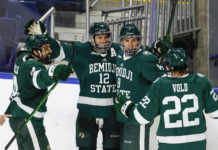It’s been a while, fellow college hockey fans. And as I return with my first blog post of the college hockey season, I bring to you some controversy from last weekend’s Union-Harvard game.
With the score 3-1 in favor of Union in the final minute of play, Harvard scored what looked to be a goal to pull the Crimson within a goal. Referees Andy O’Brien and Richard Patry called the play a goal, but Harvard’s Doug Rogers knocked down Union goaltender Corey Milan on the play, prompting the officials to replay, as the game was televised on local cable television in New York (this gives the referees the option to view the play on instant replay to ensure that their call was correct). After a short video review, though, the referees reversed the call.
The result was Harvard coach Ted Donato receiving a rare ejection, forcing him to miss the final 39.3 seconds but moreso calling into play the effectiveness of video replay.
The fact of the matter is that the replay (which can be seen here, thanks to video provided by Ken Schott at the Schenectady Gazette) clearly shows that the puck was in the net when the contact between Rogers and Milan occurs. Thus, it would be impossible for Rogers to interfere with Milan’s ability to stop the puck if contact hadn’t been made when the puck passed the goaltender.
This isn’t the first time that I’ve blogged about referees getting calls incorrect despite using instant replay. Last year, we had Magnessgate, a botched instant replay call that nearly cost Wisconsin its NCAA tournament bid.
There’s certainly no telling if the referees got the call right on Saturday night at Union whether Harvard would’ve scored again to tie the game. But it’s tough to understand why referees can’t get a call correct even when they have the benefit or watching it over and over again on replay.
